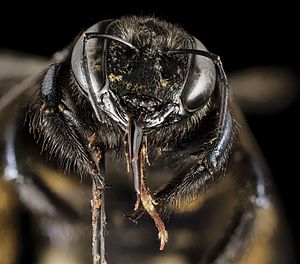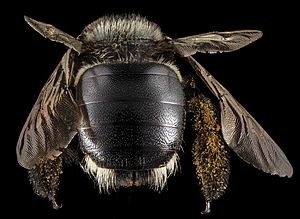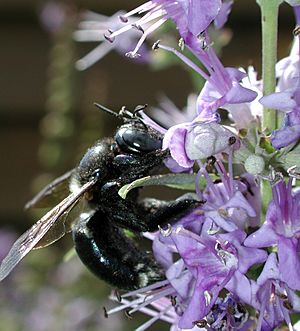Southern carpenter bee facts for kids
Quick facts for kids Southern carpenter bee |
|
|---|---|
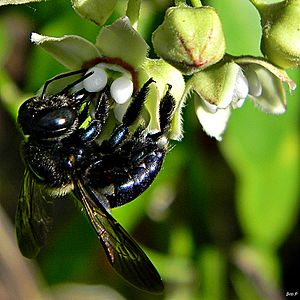 |
|
| Female nectaring on Funastrum clausum | |
| Scientific classification | |
| Genus: |
Xylocopa
|
| Species: |
micans
|
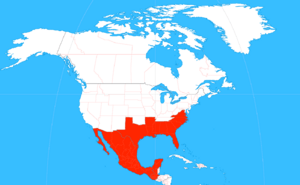 |
|
| The range of Xylocopa micans. | |
| Synonyms | |
|
Xylocopa vidua Lepeletier |
|
The Xylocopa micans, also known as the southern carpenter bee, is a type of bee. It belongs to the Xylocopa group, which are known as carpenter bees. You can find this bee mostly in the coastal and gulf areas of the southeastern United States. It also lives in Mexico and Guatemala.
Like all Xylocopa bees, the southern carpenter bee makes its nests by digging into wood. However, unlike its relative, the eastern carpenter bee, X. micans does not usually nest in the wood of buildings. This means it causes fewer problems for people. Carpenter bees have many different ways of finding a mate. The southern carpenter bee changes its mating strategy as the year goes on, from early spring to mid-summer. Most bees in its group are solitary, meaning they do not live in large groups or colonies.
Contents
About the Southern Carpenter Bee
The southern carpenter bee, Xylocopa micans, was first described in 1841 by a French scientist named Amédée Louis Michel le Peletier, comte de Saint-Fargeau. The name Xylocopa comes from an old Greek word meaning "wood-worker." This name fits because these bees dig into wood to make their homes. The species name micans is Latin for "shining," which describes the bee's shiny body. Its common name, southern carpenter bee, tells us it lives in the southern United States.
What Does the Southern Carpenter Bee Look Like?
The southern carpenter bee is a large bee. It is about 15 to 19 millimeters (about 0.6 to 0.75 inches) long. It is also about 8 to 9.5 millimeters (about 0.3 to 0.37 inches) wide. Its body is usually a shiny black color. It can also have blue or green hints when light hits it.
Male and female southern carpenter bees look mostly alike, but they have some differences in their hair. Females have thin, dark hair on their upper body. Males have thick, bright-yellow hair on the same parts. Also, females have bare sections on their abdomen (body end) with white hair tufts near the tip. Males have yellow hair on the first two sections of their abdomen and black hair on the rest.
These bees make nests by digging into dead wood. They use their strong jaws to vibrate and bore holes into the wood. Then, they dig a tunnel about 8 millimeters wide and about 12 centimeters (about 4.7 inches) long. Inside this tunnel, they create several small rooms called brood cells.
Where Do Southern Carpenter Bees Live?
You can find X. micans in several states in the southeastern United States. This includes coastal areas from southeastern Virginia down to Florida, and west along the gulf to Texas. These bees also live further south in Mexico and as far as Guatemala. In some very warm places, like the Lower Rio Grande Valley, they are only seen in the warmer months. But in most areas, they are around all year.
Sometimes, southern carpenter bees have been found moving north, even into Prairie County, Arkansas. This might be happening because of climate change, which can cause animals to move to new areas. Another reason could be human activity. These bees might burrow into wood that is then transported north for building or other uses.
Life Cycle and Nesting
All carpenter bees in the Xylocopa group are solitary. This means they do not live in large groups like honeybees. Both male and female southern carpenter bees spend the winter as adults in their old nests. They stay there until the next spring. Each bee lives for about one year. In early April, the adult bees come out of their nests to find a mate.
Female bees prefer to reuse old nests if they can. Digging a new nest takes a lot of energy. If a new nest is needed, the female bee bores a hole into a piece of wood. She then makes a sharp turn and digs a tunnel. This tunnel will have several brood cells. She digs about one inch every six days. In each brood cell, the female places a ball of pollen and nectar for food. She then lays an egg on top of the food ball. After that, she seals the cell with wood pulp. Once all the brood cells are filled, the female bee dies.
Southern carpenter bees grow from an egg to an adult in about seven weeks. New adult bees break out of their cells in late August. They collect pollen to store for the winter. Then, they quickly return to their nests to spend the colder months.
Behavior of the Southern Carpenter Bee
Male Territory and Aggression
Male southern carpenter bees are very protective of their areas, especially when it's time to mate. If another male bee tries to enter a male's territory, the bee defending its space will quickly fly towards the intruder. They might chase each other in circles for up to 30 seconds. They usually stay about 15 centimeters (about 6 inches) apart, but sometimes they touch briefly. After the chase, the intruder usually leaves. Rarely, an intruder might take over the territory.
Sometimes, a male bee might slowly fly into a neighbor's territory. The neighbor will then act aggressively, just like with an intruder. After this, the bee returns to its own territory. This behavior is called the "dear enemy effect." It means that bees living next to each other learn to recognize each other. They agree on boundaries to avoid too many fights. This saves them energy.
Southern carpenter bees also react to other types of animals. If a butterfly, wasp, or robber fly enters their territory, the male bee will quickly investigate. They usually do not make contact. This quick investigation often makes the intruder leave. Even larger animals, like humans, can be intimidated. Southern carpenter bees have been known to fly towards people who enter their territory.
Mating Strategies
The southern carpenter bee is special because it uses two different ways to find a mate. In early spring, males protect areas with lots of flowers. This is because females gather around these flowers for food. Later in the summer, around July and August, males change their strategy. They choose territories on non-flowering plants or landmarks like small hills. This is called lek mating.
When a female bee enters a male's territory, she often goes to a high spot. Males might release special scents called pheromones there. Then, the female slowly flies away. The male will then slowly follow her through his territory. Sometimes, the male chooses not to mate, showing that males have a choice too. Other times, they mate in the air. Females can also reject certain males, showing they have a choice as well.
Communication Among Bees
Scent Glands
Southern carpenter bees use special scents to communicate. They have a gland called the Dufour's gland. This gland produces chemicals that are unique to X. micans. These scents might help them tell the difference between their own species and other similar bees, like X. virginica, even when they live in the same area.
They also have a mesosomal gland, which is very important for mating communication. This gland releases scents into the air like a spray. This allows the scent to travel a greater distance and makes the male's territory seem larger. These scents act as pheromones to attract females.
The chemicals in the mesosomal gland change depending on the mating season. In early spring, when males protect flower resources, a certain chemical called ethyl oleate is only a small part of the gland's contents. However, in late summer, when males use lek mating, the amount of ethyl oleate increases a lot. This suggests that males use ethyl oleate to attract females during the later mating stages. It might also show how strong and healthy a male bee is to females. The size of this gland also changes with the mating strategy.
Foraging Behavior
Southern carpenter bees eat nectar. Males will look for food from noon until late afternoon during the summer. However, males who are defending a territory will only forage for about an hour before returning to protect their space. X. micans bees are careful when looking for food. They prefer flowers that have nectar and avoid empty ones.
These bees are also "polylectic," which means they can collect pollen from many different kinds of plants. They are good pollinators. They can even do something called buzz pollination. This is a special technique where they vibrate their bodies to shake pollen loose from flowers that hold it tightly. This ability allows X. micans to get food from a wider variety of plants.
Human Impact and Conservation
As general pollinators, southern carpenter bees are very important for many plants to reproduce in their habitats. In many places where carpenter bees live, cutting down and removing woody plants has caused bee populations to disappear. Clearing land can destroy the natural places where these bees make their nests. This can cause the bees to either die off or move to new areas. The southern carpenter bee could face similar problems if people manage dead wood in a way that removes their potential nesting sites. This issue could be even worse if X. micans is picky about the type of wood it uses for nesting.


